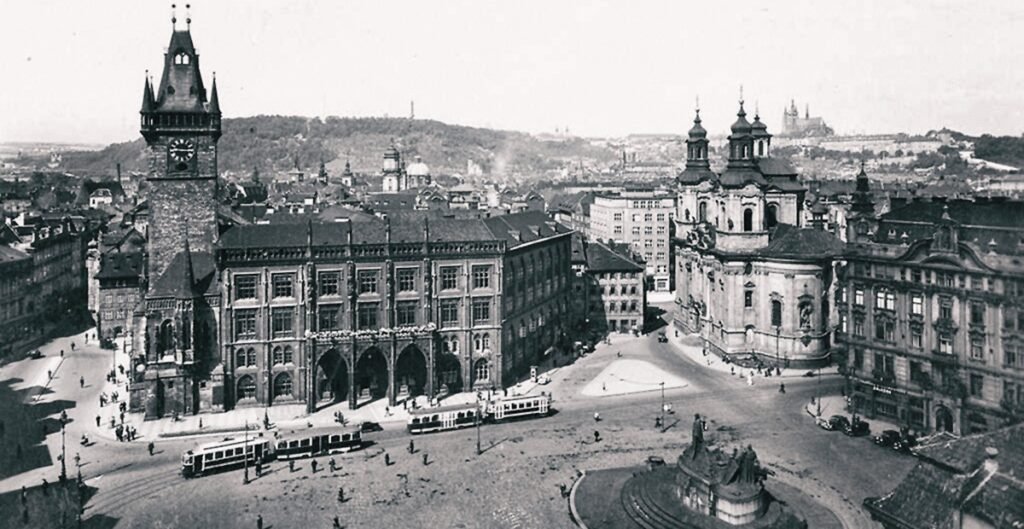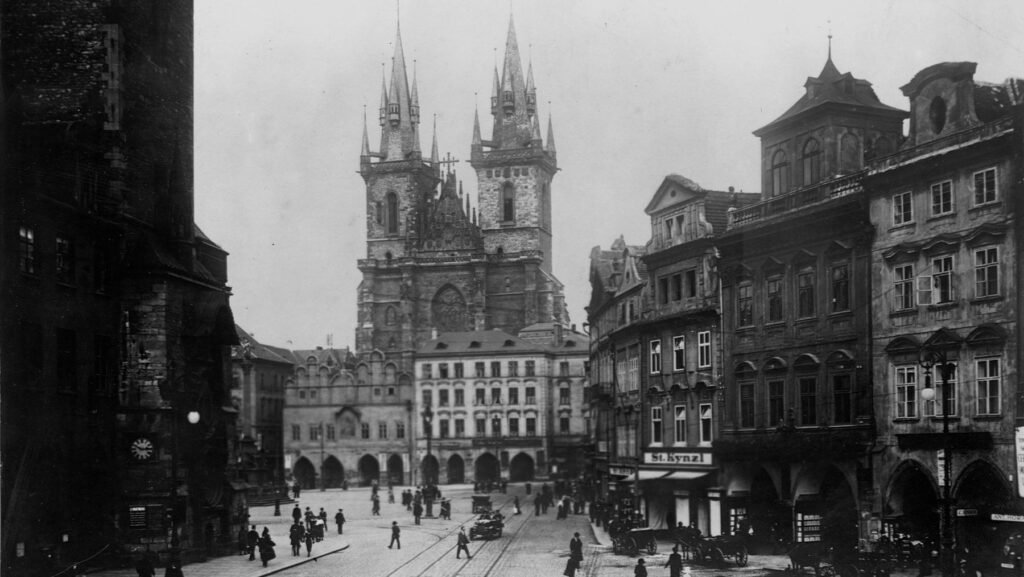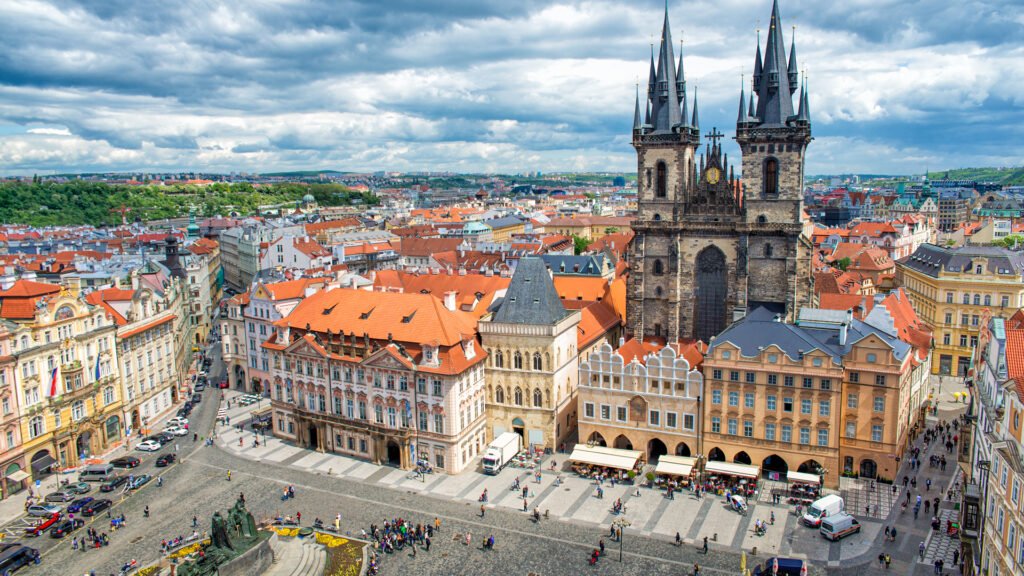Prague Then and Now
Prague Then
Prague, the capital of the Czech Republic, is a city renowned for its rich history and architectural splendor.
Situated in the heart of Europe, it has long been a significant cultural and economic hub, playing a pivotal role in the development of Central European civilization.
With a history spanning over 1,000 years, the city has witnessed various political and social changes, which are reflected in its diverse architectural styles, ranging from Gothic to Baroque to modernist influences.
Prague’s nickname, the “City of a Hundred Spires,” stems from its many historical churches and towers, although today it is believed to have around 500.

Other popular monikers, such as the “Golden City” and the “Heart of Europe,” highlight its central position in European history and its enduring charm as a cultural and historical destination.
Its unique blend of old-world beauty and modern vibrancy makes Prague one of Europe’s most beloved cities.
Related Article: Vienna Then and Now
Prague History
Prague’s history spans over a millennium and is marked by a blend of cultural, political, and economic shifts that have shaped the city into a major European hub.
Early human settlement in the region can be traced back to the Neolithic period, with Celts and later Slavs occupying the area around the Vltava River.
The first significant settlement, however, began in the second half of the 9th century, with the establishment of Vyšehrad Castle, followed by the foundation of Hradčany.
The legend of Princess Libuše and her husband Přemysl, founders of the Přemyslid dynasty, is central to Prague’s mythic origins.
Related Article: Athens Then and Now
Under the Přemyslids, Prague became the political center of the Bohemian state and developed into a thriving trading hub.
Notable figures from this period include St. Wenceslas, whose martyrdom in 939 left a lasting imprint on the city’s identity.
Prague’s growth continued through the medieval period, particularly during the reign of Charles IV in the 14th century.
Charles IV, Holy Roman Emperor, transformed Prague into one of Europe’s leading cities.
Related Article: Rome Then and Now
He founded Charles University in 1348, built the iconic Charles Bridge, and initiated the construction of St. Vitus Cathedral.
During this time, Prague saw the expansion of its urban landscape, including the establishment of New Town and the construction of important buildings such as the Carolinum and the town hall.
The city became a cultural and intellectual center, attracting scholars and merchants from across Europe.
However, Prague’s history was also marked by conflict, especially during the Reformation.
Related Article: Barcelona Then and Now

The 15th century saw the rise of Jan Hus, whose ideas influenced the Hussite movement, leading to the first Defenestration of Prague in 1419.
This uprising set the stage for a series of Hussite Wars, as Prague’s inhabitants fought against both the Catholic Church and the Bohemian monarchy.
In the 17th century, Prague suffered under the rule of the Habsburgs, with the second Defenestration of Prague in 1618 triggering the Thirty Years’ War, which led to significant social and economic decline for the city.
The city began to recover in the 18th century, with an increase in population and the growth of Baroque architecture.
Related Article: Amsterdam Then and Now
The Industrial Revolution further transformed Prague, bringing new factories, urban expansion, and a rising working class.
By the late 19th century, Prague had grown into a bustling metropolis with electric trams and modern infrastructure.
In 1918, following the end of World War I, Prague became the capital of the newly independent Czechoslovakia.
Despite the challenges of Nazi occupation during World War II and Soviet domination during the Cold War, Prague continued to thrive in the late 20th century.
Related Article: Berlin Then and Now
The city was a focal point for political change, as evidenced by the Prague Spring of 1968, a brief period of political liberalization that was suppressed by Soviet forces.
In 1989, Prague played a central role in the peaceful revolution that ended communist rule in Czechoslovakia, leading to the formation of a democratic government.
The city’s political and cultural transformation continued through the 1990s, as it became a prominent European city, attracting tourists and investment alike.
Today, Prague is a vibrant capital that blends its rich historical heritage with modern influences, making it a leading center for culture, politics, and commerce in Central Europe.
Related Article: Paris Then and Now
Prague Now

Prague, the capital and largest city of the Czech Republic, holds a significant historical and cultural position in Central Europe.
As the former capital of the Kingdom of Bohemia, Prague is rich in history and is a major political, cultural, and economic hub.
Situated along the Vltava River, the city offers a picturesque setting with its winding watercourses, reservoirs, and notable hills.
Related Article: London Then and Now
The Vltava, which flows through Prague, is complemented by other water features such as the Berounka River and various ponds, making the city visually appealing and contributing to its unique landscape.
The highest point in Prague is the Teleček Hill, offering expansive views of the surrounding areas, while hills like Petřín and Vítkov add to the city’s charm and historical significance.
The city’s geography is diverse, with the Prague Plateau dominating most of the area, while the southern edge extends into the Hořovice Uplands.
Related Article: Phnom Penh Then and Now
Prague’s location at a latitude similar to cities such as Frankfurt, Paris, and Vancouver places it in a temperate zone, giving it a climate that is conducive to both urban living and outdoor activities.
With a total of 99 watercourses and a number of reservoirs and ponds, Prague’s landscape is a blend of urban development and natural beauty, which is reflected in its recreational areas and the quality of life for its residents.
Prague is a thriving metropolis with a population of about 1.4 million people, making it the largest city in the country.
Related Article: Kathmandu Then and Now
It is home to numerous cultural institutions, including over ten major museums, theatres, and galleries, which highlight the city’s artistic and historical legacy.
The city is also known for its educational institutions, such as Charles University, the oldest university in Central Europe, underscoring its role as a center of learning.
As an “Alpha-” global city, Prague is a key player in international trade, culture, and tourism, and its high livability rankings reflect the quality of life available to its residents and visitors alike.
Related Article: Colombo Then and Now
The city has become one of Europe’s most visited destinations, attracting millions of international tourists annually due to its beautiful architecture, vibrant culture, and historical landmarks.
Prague’s modern public transportation system helps to efficiently connect the city’s different neighborhoods, making it accessible for both locals and tourists.
The city’s infrastructure also supports its growing population and vibrant economy, with substantial investments in urban development.
Related Article: Dhaka Then and Now
In addition to its historical and cultural prominence, Prague is a key city for international business and has earned a reputation for being one of the most livable cities in the world.
Its strategic location in Central Europe, rich history, and diverse landscape make Prague a city of both historical importance and modern significance.
Related Article: Lahore Then and Now
FAQs
No, Prague is not in Germany. It is the capital city of the Czech Republic, a neighboring country to Germany in Central Europe.
Prague is famous for its rich history, stunning architecture, and cultural heritage.
Key attractions include Prague Castle, Charles Bridge, and Old Town Square, making it a popular tourist destination.
It is also known for its vibrant arts scene and its role as the historical capital of Bohemia.
Prague is in the Czech Republic, which is located in Central Europe.
Compared to many Western European cities, Prague is relatively affordable.
The cost of living, including accommodation, food, and transportation, is lower than in cities like Paris, London, or Berlin, making it an attractive destination for tourists and expatriates.
However, it is more expensive than some Eastern European countries.






























